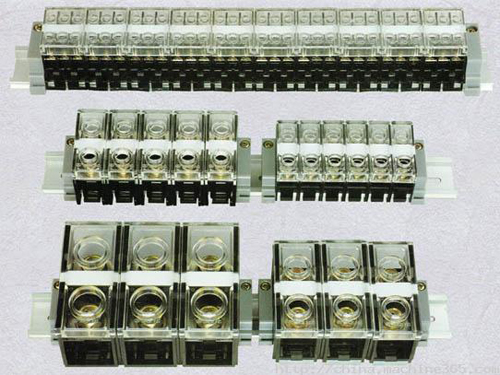The plastic insulation and conductive parts of the terminals are directly related to the quality of the terminals, which determine the insulation and electrical conductivity of the terminals. Failure of any of the terminals will result in failure of the entire system engineering. The painful lessons that have taken place at home and abroad in this regard are very profound.
Prevention is the purpose and analysis is the foundation. In a sense, preventing failures is more important than analyzing failures. It has a more realistic meaning for ensuring the quality and reliability of the terminals.
From the point of view of the use of the terminal, the function that should be achieved is that the contact area must be conductive and the contact is reliable. The place where the insulation should not be turned on must be insulated and reliable. There are three common types of fatal faults in Terminal Blocks:
Poor contact
The metal conductor inside the terminal is the core part of the terminal that transfers the voltage, current or signal from the external wire or cable to the corresponding contact of the mating connector. Therefore, the contact member must have an excellent structure, stable and reliable contact retention and good electrical conductivity. Due to the unreasonable design of the contact structure, the wrong selection of materials, unstable mold, poor processing size, rough surface, unreasonable surface treatment process such as heat treatment plating, improper assembly, poor storage and use environment, improper operation, will be in the contact parts. Contact and fitting parts cause poor contact.
2. Poor insulation
The function of the insulator is to keep the contacts in the correct position and to insulate the contacts from the contacts and the contacts from the housing. Therefore, the insulation must have excellent electrical properties, mechanical properties and process forming properties. In particular, with the high density and wide use of miniaturized terminals, the effective wall thickness of the insulator is getting thinner and thinner. This puts more stringent requirements on insulation materials, injection mold precision and molding processes. Due to metal impurities on the surface or inside of the insulator, surface dust, flux and other pollution are damp, organic material precipitates and harmful gas adsorption film and surface water film fuse to form ionic conductive channels, moisture absorption, mildew, insulation material aging and other reasons, It will cause short circuit, leakage, breakdown, low insulation resistance and other insulation problems.
3. Bad fixation
The insulator not only acts as an insulator, but also provides precise centering and protection for the extended contacts, as well as mounting and locking to the device. Poor fixing, light contact affects reliable momentary power outage, and serious product disintegration. Disintegration refers to the abnormal separation between the plug and the socket between the plug and the socket caused by the unreliable structure due to the material, design, process, etc., which causes the control system to transmit power and The serious consequences of signal control interruption. Due to unreliable design, incorrect material selection, improper selection of molding process, poor quality of heat treatment, mold, assembly, welding, etc., assembly failure, etc. will result in poor fixation.
In addition, due to coating peeling, corrosion, bumping, plastic shell flashing, cracking, rough processing of contact parts, deformation and other reasons caused by poor appearance, due to the positioning of the locking fit, the processing quality is poor, the total separation force Poor exchange caused by a large number of reasons is also a common disease and frequently-occurring disease. These kinds of faults can generally be found in the inspection and use process in time.
Reliability screening test for prevention of failure
In order to ensure the quality and reliability of the terminal block and prevent the occurrence of the above-mentioned fatal fault, it is recommended to study and formulate the corresponding screening technical requirements according to the technical conditions of the product, and carry out the following reliability test for the prevention of failure.
1. Prevent contact failure
1) Conduction detection
At present, the general terminal manufacturer's product acceptance test does not have this item, and the user generally needs to conduct conduction test after installation. Therefore, it is recommended that manufacturers should increase the point-by-point conduction test by 100% for some key models.
2) Instantaneous detection
Some terminals are used in a dynamic vibration environment. The experiment proves that it is only qualified to check whether the static contact resistance is qualified, and it cannot guarantee the reliable contact in the dynamic environment. Because the connector with good contact resistance often exhibits instantaneous power failure during vibration, shock and other simulated environmental tests, it is better to test the dynamic vibration test of some high reliability terminals. Contact reliability.
3) Single hole separation force detection
The single-hole separation force refers to the separation force in which the contact member in the engaged state changes from static to moving, and is used to characterize that the pin and the socket are in contact. Experiments show that the single-hole separation force is too small, which may cause signal transients when subjected to vibration and shock loads. It is effective to check the contact reliability by measuring the single hole separation force to measure the contact resistance. Check that the single hole separation force is too poor, the measured contact resistance is still qualified. To this end, in addition to the development of a new generation of flexible plug contacts with stable and reliable contact parts, the production plant should not use the automatic insertion force tester for multi-point measurement of key models, and 100% point-by-point processing for finished products. Hole separation force check to prevent signal breakage caused by individual jack relaxation.
2. Prevent insulation failure
1) Insulation inspection
The quality of raw materials has a great influence on the insulation properties of insulators. Therefore, the choice of raw material manufacturers is particularly important, and it is impossible to reduce the cost and lose the material quality. You should choose the reputable material of the big factory, and carefully check the inspection lot number, material proof and other important information for each batch of materials, and make traceable information on the use of materials.
2) Insulation insulation resistance inspection
At present, some of the production plant processes are required to be assembled into finished products and then tested for electrical properties. As a result, the insulation of the insulator itself is unqualified, and only the entire batch of finished products is scrapped. A reasonable process should be 100% process screening in the state of the insulator parts to ensure electrical performance.
3. Prevention of poor fixation
1) Interchangeability check
Interchangeability checks are a dynamic check. It requires that the same series of plugs and sockets can be mated to each other, and it is found that there is no difference in the size of the insulators, contacts, etc., the missing parts or the assembly is not in place, etc., which cannot be inserted, positioned and locked. Even under the action of the rotating force, it causes disintegration. Another function of the interchangeability check is to find out whether there are metal surpluses that affect the insulation performance through plugging and unplugging, such as threads and bayonet. Therefore, for some important applications, the terminal should be 100% checked to avoid such major fatal failures.
2) Torque resistance check
Torque resistance inspection is a very effective inspection method to assess the reliability of the terminal structure. Such as the US military standard MIL-L-39012 standard. According to the standard, each batch should be sampled for torque resistance inspection, and problems should be discovered in time.
3) General measurement of crimped wires
In the electrical installation, it is often found that the individual core crimping wires are not in place, or cannot be locked after being sent to the position, and the contact is unreliable. The reason for the analysis is that there are burrs or dirt stuck in the screw holes of the individual mounting holes. In particular, the use of the factory has been installed in the last mounting holes of a plug socket, and it is found that after the ill, the other crimped wires of the other holes have to be unloaded one by one, and the plug is replaced again. In addition, due to the improper matching of the wire diameter and the crimping aperture, or due to the operation of the crimping process, the crimping end is not secure. To this end, the manufacturer must pass all the mounting holes of the sample of the plug (seat) of the delivery before the finished product leaves the factory, that is, use the loading and unloading tool to send the wire crimped with the pin or jack to the position, check whether Locked. According to the technical requirements of the product, the pull-out force of the crimping wires is checked one by one.
Without reliable terminals, there is no reliable system engineering. Failure and reliability are two aspects of a contradiction that are corresponding and interconnected. Through the reliability screening of terminal blocks, various failure modes and failure mechanisms are found, which can lead to a lot of lessons and eliminate various hidden dangers, and provide scientific basis for improving design, process, inspection and use. It is also important to revise and formulate technical conditions of terminal blocks. in accordance with. Finding measures to prevent failure and achieving a transition from failure to reliability is the ultimate goal of failure analysis.









